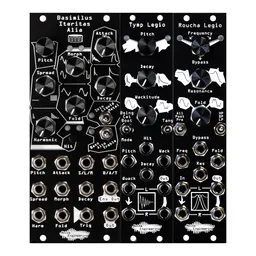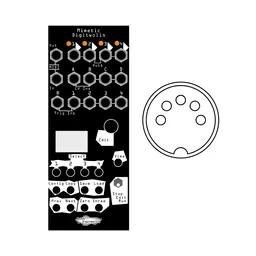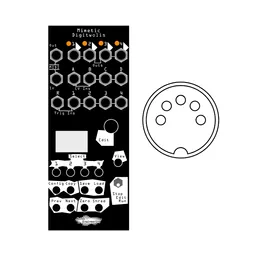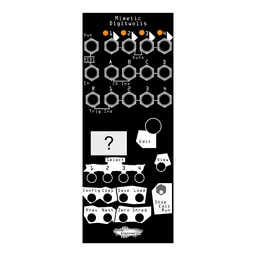Mimetic Sequent came out a few years ago and it’s the module of ours we think people are most confused about. So today we wander into the weeds with MS and its expander, Mimetic Multium. Good luck! You’ll need it! Just kidding! Not really!
Ok, but really, WTF is Mimetic Sequent
It’s a random CV source, a CV recorder, a CV randomizer, a quad random trigger generator (with its expander), and a whole lot of fun.
When I first got my MS and MM, I was confused, dazed, confused, and also confused. There were a lot of switches that all seemed to interact-- but how? There was a big, enticing knob in the middle. And there were buttons. Oh the buttons. What did any of these things do? Let’s talk about the Random knob first, because it’s kind of the point of MS.
It’s a knob that says random so you can probably guess what it does
It randomizes things.

Good ol’ MS.
Ok...let’s talk about how it randomizes stuff, because there’s a lot of ways you can customize your randomization to suit your needs!
For all modes, the amount of randomization is based on the knob position. Turn the knob more, get more random! The way CV is randomized is based off what Mode you’re in. MS has three modes: 5c, 5p, and 2p.
5c mode is made for CV randomization: it randomizes across 5 volts but without any consideration or notion of pitch. 5c randomizes CV based on motion: the farther clockwise the knob is, the further the CV can deviate from its original step value.
The two “p” modes are meant for pitch sequencing: in 5p and 2p modes, MS randomizes using an algorithm that considers the current pitch and moves within musically useful intervals. 2p will randomize over two octaves, while 5p offers the option to randomize across five. Although these were designed with pitch sequencing in mind, they can clearly be used in any sort of modulation.
There’s also the 12-tet switch: do you need to quantize your cv sequence? Flip this switch on to quantize the output to the chromatic (12-tet) scale. Simple enough!
All byyyyy myyyyseeeeeeeelf
MS works wonders in a patch generating its own randomized sequences, so let’s take a look at that.
All we need to do is patch a clock to the Beat input, turn up the Random knob, and we’re generating CV! Patch the CV output to something you want to modulate, like maybe a filter cutoff or a tonal parameter on an oscillator and you can hear what it’s doing. Find a pattern you like? Turn the Random knob down. This saves the generated pattern to flash and stops randomizing it. Want to change it up a bit more? Turn Random up again!
Want to generate random quantized melodies? Just activate 12-tet and switch Mode to 2p or 5p! Whoa!
As you can see, using MS can be very straightforward and simple. That’s just a couple of patch points and we’ve already got a cool controlled-random sequencer! Fun stuff.
...but what about that recording thing I keep hearing about?
MS is often billed as a CV recorder, but a lot of people don’t realize that the CV recording was really an afterthought when we made it! That said, we were pretty happy with it and it’s a pretty useful function, so let’s discuss.
MS has two ways to record CV. There’s short record mode, which records until it reaches 64 steps or you send it a trigger at the Measure input. Then, there’s indefinite record mode, which records forever until you flip the Record switch off. MS can playback a maximum of 64 steps no matter how you record them, so this is more a workflow preference.
MS records CV based around the Beat triggers you send it: think of it kind of like a sample and hold that records the samples. Each time you send it a trigger to the Beat input, it records the current value at the CV input to that step. If the Record switch is all the way down (off), it just plays back what’s recorded like a normal sequencer.
Enough already. Let’s get to the part where we make more patches.
Let’s try recording/randomizing in a patch. In our previous patch, we had a clock going to our Beat input and the CV out going to a modulation destination. We can randomize and record an external CV sequence simply by patching it to MS’s CV In jack!
I like to use Mimetic Digitalis for this in my patches. I drive MD and MS off the same clock and put MS in continuous record mode.
There are a few things we can do from here: first, I like to press the Duplicate button. This stores identical copies our recorded pattern to each of MS’s three pattern slots (yes, you can store THREE WHOLE PATTERNS in MS!) so we can modify them separately if we want to. Next, I like to start conservatively in 2p mode. I’ll still get randomization, but it won’t be across a crazy range so it’ll be good for pitch sequences; feel free to go nuts with 5c mode if that suits you. Turning the Random knob up a little less than half way gets us a decent amount of deviation from our original pattern, but nothing toooooo ridiculous. Once I hear a variation I like, I turn the knob down and that saves the randomized pattern. Then, I can flip the Pattern switch to another position and repeat the process to create another randomization. Usually, I’ll keep one copy unmodified and then create two randomized variations in the other slots. This means I can switch between patterns in a performance to add some nice variety, or even CV to different patterns. Controlled random==yes please!
My favorite way to use MS: a weird quantizer thing
One of my favorite sets of modules in all of Eurorack is 2x Pressure Points, 2x Analog Memory, and a Brains, from Make Noise. Oldschool! It creates this fun 8x8 analog-style sequencer that’s super dynamic, interactive, and fast to use. None of the outputs are quantized, though, meaning it’s not great for pitch by itself. Here’s where MS comes in! Like we mentioned earlier, the 12-tet switch activates a quantizer on the output of MS. This means that in continuous record mode with random turned all the way down, MS is basically just a quantized sample-and-hold. Fun!
Learn more:
But is a normal quantizer all that fun? Not really! That’s where MS’s randomization features come in.
Turning the random knob up just a bit means that an 8 step sequence gets some much-needed variation added in every once in a while. In fact, I’ll often use another sequencer row on the Pressure Points/Brains/Analog Memory system to CV the randomization amount. This means that I can have a sequence where, say, steps 1-5 aren’t randomized at all, steps 6-7 are randomized a little, and 8 is randomized a lot, to keep things interesting.
Kris is way more creative than me: MS as a generative thing
A while back, Kris told me about one of her favorite uses of the MS/MM combo: a generative “sequencer”. MS can generate CV by itself without a CV input, which is pretty cool. Run a clock to the Beat input, crank up the Random knob, and you start getting interesting patterns coming out of it. When you have something you like, turn the random knob all the way down to save the sequence, flip on to the next pattern and repeat. For maximal generative power, just keep the random up a little bit and walk away.
The Mimetic Multium expander has outputs for all three patterns simultaneously, so you can use them all at the same time. You can also switch between the patterns on MS to randomize and modify each one gradually throughout a performance. Trigger your sound sources with the four Trig outs on MM, too, and you’ve got a whole bunch of generative weirdness at your fingertips. Cool stuff. [note from Kris: if you know me, generative music isn’t what I normally do, but the MS is the key to it when I do. I love to set up a patch like this and then chill on the couch with a book.]
Let’s try this out
We’ve done a lot of talking, but let’s actually hear what we can do with this. Here, MS sequences Cursus Iteritas Percido, generating a melody for it. CIP is also modulated by some incredibly slow LFOs from Pons Asinorum, another great module for this style of patch!
In conclusion: maybe MS is less confusing now?
MS (plus MM) is a great module. It’s the module people are probably most confused about, and to be fair, it’s kinda weird. It has a long manual with lots of technical talk in it. And there’s some ominous-looking (but totally hypoallergenic) shellfish on the panel. But once you’ve gotten used to the workflow of it a little bit, it’s a fun, performance-ready, dynamic module. Even people who thrive on order can find use for this little guy. If you’re looking for a little more random joy in your system, look at the MS!






